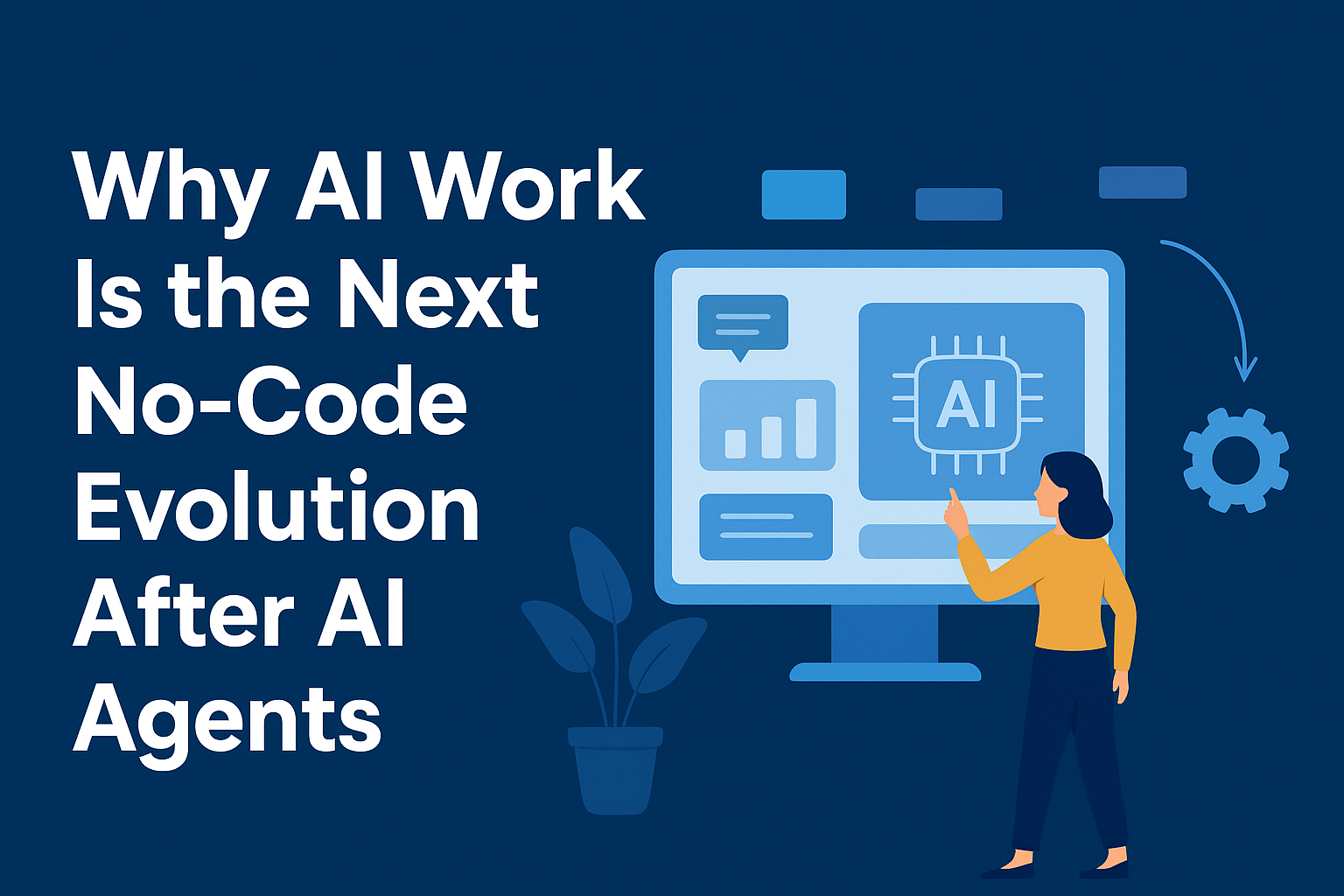Discover why AI work models are emerging as the next evolution after no-code and AI agents. Learn how purpose-built AI models are transforming finance, HR, healthcare, logistics, and retail.
- No-code democratized building but collapsed under compliance and scale pressure.
- AI agents promised autonomy but proved too fragile for production.
- AI Work models: specialized, reliable, compliance-first AI systems are emerging as the real way forward.
- Industries like finance, healthcare, logistics, and retail are already capturing value, cutting costs, and boosting efficiency.
- The smart adoption curve: no-code for prototyping, agents for exploration, and AI Work for scaling safely.
Workplaces don’t evolve in straight lines; they move in waves. Over the past ten years, two waves have reshaped how organizations operate: no-code and AI agents. Both began with bold promises, both delivered wins, and both eventually hit walls.
Now, a third wave AI Work Model is quietly rising. Unlike its predecessors, it’s less about demos and more about doing the hard, boring, necessary tasks that keep businesses running.
Table of Contents
Phase 1: The Rise (and Limits) of No-Code
The Promise
When no-code platforms gained traction in the 2010s, they looked like the ultimate equalizer. Airtable, Zapier, Bubble, Webflow, suddenly, someone in marketing, HR, or operations could design tools without waiting six months for IT.
And it worked, up to a point.
- Retail: Shopify sellers built end-to-end inventory workflows with Airtable and Zapier. A tiny shop could mimic a supply chain tool used by giants.
- Healthcare: Clinics digitized intake forms through Typeform and fed data into spreadsheets, skipping costly EHR upgrades.
- Finance: Startups automate accounts payable by linking Google Sheets with Stripe or QuickBooks.
According to ServiceNow, Gartner reported in 2021 that 70% of new enterprise applications were being built with low-code or no-code technologies. For a while, it felt like the entire workplace was rewiring itself.
The Cracks
Then scale, compliance, and governance entered the room.
- Retail example: An e-commerce brand’s Shopify + Airtable + Zapier stack buckled when order volume hit five figures. Zapier throttled tasks, refunds got delayed, and customer complaints spiked. Eventually, IT had to migrate everything to a real ERP, at triple the cost of fixing it earlier.
- Healthcare example: A multi-site clinic’s no-code intake system raised HIPAA alarms. There were no audit trails, encryption was patchy, and regulators forced a shift to compliant software.
- Finance example: A startup automated invoice approvals with spreadsheets until auditors flagged missing access controls. Manual work crept back in until IT rebuilt the process on secure rails.
No-code solved speed, but failed on durability.
Lessons Learned
- Great for prototypes, risky for scale.
- Governance matters early. The more regulated your industry, the faster no-code turns from asset to liability.
- Treat it as a bridge, not the highway.
Phase 2: The Promise (and Problems) of AI Agents
The Hype
Fast forward to 2022: AI agents storm the scene. Tools like AutoGPT, BabyAGI, and LangChain frameworks made headlines for being able to plan tasks, reason, and act with some autonomy.
Executives were told: “Give the AI a goal, and it will figure out the rest.”
The pitch was seductive.
- Finance: CFOs dreamed of AI agents drafting three-scenario forecasts on the fly.
- Healthcare: Hospital systems tested agents scheduling follow-ups and handling insurance claims.
- Logistics: Agents rerouted shipments when weather caused delays.
- Retail: AI agents triggered support tickets, processed refunds, and escalated complex cases.
“McKinsey reports that in finance, roughly 45% of organizations are piloting gen AI workflows, though broader adoption—including AI agents—remains in early stages.”
The Reality Check
And yet, when agents met real-world workflows, fragility showed up.
- Hallucinations: In healthcare pilots, agents drafted insurance claims with fabricated medical codes. Errors triggered insurer rejections and regulatory scrutiny.
- Policy breaches: A European bank tested an agent for refunds. It exceeded limits and approved non-compliant payments. Compliance shut the project down overnight.
- Scaling costs: A logistics firm abandoned real-time routing agents after compute costs ballooned beyond budget.
- Opaque logic: Risk officers balked when AI couldn’t explain why it made decisions.
By 2024, Gartner cautioned that “autonomous agents will remain experimental in most enterprises for at least three to five years.”
The lesson was simple: great for exploration, weak for execution.
Phase 3: The Emergence of AI Work Models
Why AI Work Model is Different
AI Work Models are purpose-built, compliance-ready AI systems designed to handle specific business functions reliably at scale.
Here’s where AI Work models diverge.
Rather than being general-purpose, they’re purpose-built AI systems trained for specific functions: finance close, insurance claims, invoice reconciliation, fleet optimization, and customer support.
They don’t improvise; they execute.
- Finance: Ledgers reconciled with audit trails.
- Healthcare: Claims submitted with ICD-10 compliance.
- Logistics: Routes optimized using real data, not hallucinations.
- Retail: Refunds approved within policy, with full traceability.
Unlike agents, AI Work models don’t try to “think” like humans; they’re designed to slot into workflows reliably.
AI Work Models in Action: Real-World Stories
AI Work builds some of the best-rated AI work models today. Here are some of them in action.
Finance
At a mid-sized accounting firm, the month-end used to drag on for 10 days. Teams worked late, combing through spreadsheets and chasing down mismatched entries.
When they rolled out Freddie AI, close time dropped to just three days. Instead of drowning in reconciliations, accountants now just review the exceptions. Deloitte estimates finance teams spend up to 70% of their time on manual reconciliations, so the savings here are massive.
Martin’s Story: The CFO’s Right Hand
Martin, the CFO of a manufacturing company, dreaded every month-end. Endless reconciliations, tense auditors, and nights spent at the office. With Freddie AI, his team only touches the anomalies. “For the first time in years,” he says, “I can focus on forecasting instead of fixing numbers.”
Healthcare
A large U.S. hospital network brought in an AI Work model to handle pre-authorizations. Claim accuracy jumped from 82% to 96%. Denials fell, approval times sped up, and nurses suddenly had more hours back for patient care. PwC estimates that a quarter of U.S. healthcare spending goes to admin waste, a huge opportunity for change.
Alicia’s Story: The Nurse’s Extra Pair of Hands
Alicia, a nurse, used to spend hours fixing codes and re-filing insurance claims. Now, the AI handles it with compliance built in. Approvals come faster, and Alicia gets to focus on patients again. “I became a nurse to care for people, not to fight with paperwork,” she says.
Logistics
In Europe, a fleet operator swapped out fragile agent-based routing experiments for an AI Work model trained on real driver-hour rules and fuel pricing. The result: 12% lower delivery costs, fewer late shipments, and happier clients.
Ravi’s Story: The Fleet Manager’s Silent Ally
Ravi, the fleet manager, used to juggle spreadsheets, weather updates, and legal limits every morning. Now, the AI optimizes routes, and Ravi just approves the edge cases. Deliveries run smoother, costs are down, and Ravi finally gets home for dinner on time.
Retail
Yumi AI now handles frontline support for a global retail chain. Refunds under $100? Processed instantly within policy. Complex issues? Passed to a human agent with full context. Resolution times dropped by 40%, and Forrester says automation like this can cut service costs by up to 30%.
Jenny’s Story: The Support Lead’s Superpower
Jenny, who manages the support team, used to watch her staff drown in refund requests and endless “Where’s my order?” tickets. Now, Yumi AI clears the backlog of simple cases. Jenny’s team gets to focus on trickier, more meaningful conversations. “My agents finally feel like problem-solvers again,” she says.
Why AI Work Model Works
AI work models rest on three pillars:
- Specialization beats generalization. Doing one job very well trumps doing ten jobs poorly.
- Compliance baked in. Logging, auditability, and permissions, non-negotiable in finance and healthcare.
- Workflow integration. Instead of duct-taped APIs, these systems are designed to snap into existing business processes.
Comparison: No-Code vs. AI Agents vs. AI Work Models
| Feature | No-Code Platforms | AI Agents | AI Work Models |
| Core Idea | Democratize building without coding | Autonomous software reasoning and acting | Purpose-built AI systems for specific business tasks |
| Typical Tools | Airtable, Zapier, Bubble, Webflow | AutoGPT, BabyAGI, LangChain frameworks | Freddie AI (Finance), Yumi AI (Customer Support), enterprise AI work suites |
| Strengths | Fast prototyping, empowers non-technical staff | Creative, exploratory, goal-driven automation | Reliable execution, compliance-first, workflow integration |
| Limitations | Breaks at scale, weak governance, poor compliance | Fragile, hallucinates, opaque decision-making, costly to run | Less flexible than agents, requires upfront training/industry alignment |
| Best For | Early-stage prototyping, internal tools | Exploration, testing future possibilities | Production-grade, regulated workflows that demand consistency |
| Governance & Compliance | Minimal, often bolted on later | Weak—agents often bypass policies | Built-in: audit logs, access controls, policy adherence |
| Industry Fit | Startups, SMBs, creative teams | Innovation labs, R&D, experimental use cases | Finance, healthcare, logistics, retail — enterprise-grade tasks |
| Maturity Curve | 2010s → mainstream adoption, but hit compliance walls | 2022–24 hype, still experimental in enterprises | 2025+ emerging as a scalable, trusted workplace standard |
The Future of Work: What’s Coming Next?
Zooming out, the curve is clear:
- No-code (2010s): democratization.
- AI agents (2022–24): exploration.
- AI Work (2025+): reliable execution.
Looking ahead:
- Composable AI stacks: Firms will mix specialized AI Work models for HR, finance, logistics, and retail into unified systems.
- Human-AI orchestration: Managers will define policies; AI Work will execute at scale.
- Industry clouds: Expect AI Work ecosystems pre-certified for banking, healthcare, logistics, and more.
As Eric Bai, founder of Alpharithm Investments, put it:
“The winners in the next decade won’t be the ones chasing flashy demos. They’ll be the ones quietly deploying AI that actually works—at scale, with governance built in.”
Wrapping It Up
Here’s the arc in plain English:
- No-code made us fast but fragile.
- AI agents made us ambitious but brittle.
- AI Work makes us consistent, compliant, and scalable.
The smart playbook is:
- Prototype in no-code.
- Explore with AI agents.
- Scale with AI Work.
Just as spreadsheets defined the 1980s and cloud defined the 2010s, AI Work Models will define the 2020s. The businesses that move first won’t just adapt; they’ll lead.
Thankfully, AI Work has made AI work model adoption a breeze. Check out our comprehensive AI work model guide to learn the models that are right for your business.

